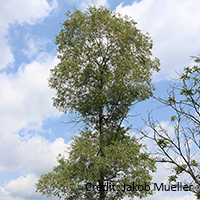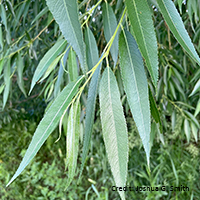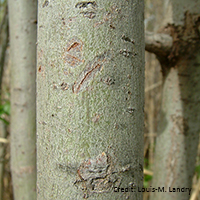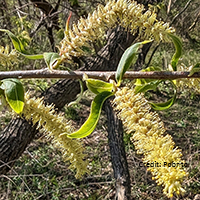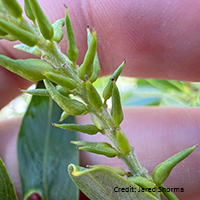What peachleaf willow looks like
Size and shape
- Reaches 20 metres high.
- Single trunk reaches up to 40 centimetres in diameter.
- Trees often have several trunks.
Leaves
- Green on top and whitish below (5 to 14 centimetres).
- Narrow with finely toothed margins, a pointed tip and a rounded base.
Bark
- Reddish-brown when young.
- Becomes greyish brown with age.
- Furrowed with flat, shaggy ridges.
Flowers
- Yellowish-green flowers grow in loose clusters (3 to 9 centimetres).
- Bloom from May to June.
Fruit
- Red or yellow capsules (4 to 7 millimetres) grow on stalks (1 to 2 millimetres).
- When mature, capsules break into 2 halves, releasing a cottony seed.
Where peachleaf willow is found
Peachleaf willow is found in Southern Ontario.
What you need to know to grow peachleaf willow
- Moisture: grows best in wet to moist soils.
- Soil: grows in a variety of soils.
- Shade: grows best in full sun.
- Caution: peachleaf willow trees require a lot of water to grow.
Benefits and uses of peachleaf willow
Wildlife benefits
Peachleaf willows are a food source for many species. Many birds and squirrels eat the buds, flowers and developing seed capsules. White-tailed deer browse the leaves and twigs. Beavers also eat branches and use them to build dams and lodges.
Commercial uses
Peachleaf willow trees are commonly planted as ornamental shade trees. Peachleaf willow wood can be used to make:
- furniture
- mats
- drums
- hunting lodge polls
- meat-drying racks
- baskets woven from thin branches
Peachleaf willow bark contains salicylic acid (aspirin) which has medicinal value and has been used to make teas to treat:
- fever
- pain
- irritated eyes
- swollen neck glands
Fun facts about peachleaf willow
- Peachleaf willow trees grow as far south as Mexico.
- Peachleaf willow trees can be grown from cuttings.
Updated: November 22, 2023
Published: July 18, 2014
